On January 1, 1863, Turkey issued its first adhesive postage stamps. It was the second independent country in Asia to issue adhesive stamps, preceded only by Russia in 1858.
Turkey's stamps came less than two years after its neighbor and former territory, Greece (independent 1832), issued its first stamps.
Tughra issue
The design consists of the tughra, the Turkish emblem of sovereignty, for the then current ruler Sultan Abdülaziz, over a crescent bearing the inscription in Ottoman Turkish Devleti Aliye Osmaniye, or "The Sublime Ottoman Empire". Between some of the stamps there is a control band with the words Nazareti Maliye devleti aliye, or "Ministry of Finance of the Imperial Government". The stamp was designed and lithographed at the Constantinople mint, and the writing is entirely in Turkish using Arabic script.
Ever since the first stamps of the Sublime Empire appeared in the reign of Abdul Aziz, much has been written by philatelists, upon the subject, and the continued philatelic fidelity to the Thoughra (the Sultan's sign manual) on the Turkish stamps.
The verse which, in the Koran, sets forth the alleged prohibition is transcribed:—
O believers! surely wine and games of chance, and statues, and the divining arrows are an abomination of Satan's work! Avoid them that ye may prosper.
In Turkey it was taken to imply the forbidding of all figures.
"Duloz" issue
 |
| Source. |
The Duloz stamps were typographed or relief printed and the
design consists of a central oval enclosing a crescent and star with radiating
lines, and "have a distinctly oriental character". Each value was printed in
a single color. Turkish writing in Arabic script is overprinted on the oval in
black, stating Postai devleti Osmaniye or "Post of the Ottoman Empire".
The bottom inscription states the denomination in para, or fortieths of a piastre
(kuruş), and accordingly differs on each value.
 |
| Source |
Empire issue
The Empire issue was first issued in September 1876, following Turkey's entry into the Universal Postal Union, and unlike the preceding Duloz issue, bore the name of the country and the values in Western characters as well as Arabic. They were intended for use to countries in the UPU, but in March 1888 became officially valid for domestic use.The Empire stamps were issued from 1876 to 1890.
The design of the Empire issue consists of a crescent, with ends pointing
upward, surrounding Arabic script, which reads, like the Duloz stamps, "Post of
the Ottoman Empire". In the bottom center of the crescent itself appears, also
in Arabic writing, the denomination, e.g. 20 Paras or 2 Piastres. In side-panels
to the lower left and right of the crescent appear only the numerical value, but
in Turkish numerals. Below the crescent is a label with the works EMP:
OTTOMAN, that is, Ottoman Empire, and below the label is the value in
western numerals and letters, e.g. "2 Piastres".
The stamps were typographed in two colors, except for the postage dues, which were printed only in black. There is a background composed of calligraphic letters, in mirror image, reading Postai devleti Osmaniye, or "Post of the Ottoman Empire", and the Turkish year date 1291, equivalent to 1875. The color combinations used are often striking.
 |
| Source |
 |
| Source |
From 1901 through 1911, Turkey issued a number of stamps with similar designs including the Tughra of the reigning monarch.[21]
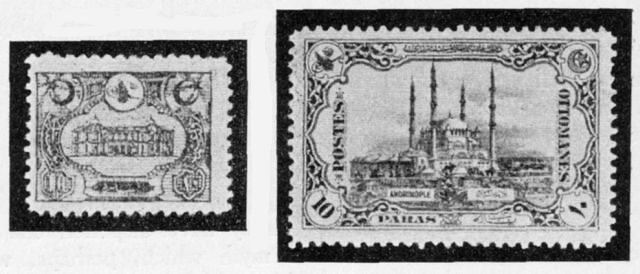
In early 1914, a series of finely engraved stamps, some in two colors, was issued depicting scenes of Constantinople and other images.
On January 15, 1914, a fine new set of London-printed stamps was issued depicting a number of scenes in the Turkish Empire and a portrait of H.M. Sultan Muhammed V. They were designed by Oskan Effendi and printed by Bradbury, Wilkinson & Co. in England, and also have a more international appearance to them.
The vignettes of the full set of the 1914 issue are:
| 2 | paras, | mauve. | Hippodrome Obelisk. |
| 4 | " | sepia. | Column of Constantine. |
| 5 | " | purple-brown. | The Seven Towers. |
| 6 | " | deep blue. | Leander's Tower. |
| 10 | " | green. | Fanaraki. |
| 20 | " | scarlet. | Castle of Europe. |
| 1 | piastre, | bright blue. | Sultan Ahmed Mosque. |
| 1½ | " | carmine and black. | Martyr's Monument. |
| 1¾ | " | grey and red-brown. | Bathing Fountains of Salem. |
| 2 | piastres, | green and black. | Cruiser Hamidieh. |
| 2½ | " | orange and green. | Candilli. |
| 5 | " | deep lilac. | Ministry of War. |
| 10 | " | red-brown. | Sweet Waters of Europe. |
| 25 | " | dull yellow-green. | Suleimanieh Mosque. |
| 50 | " | rose. | The Bosphorus. |
| 100 | " | indigo. | Sultan Ahmed's Fountain. |
| 200 | " | green and black. | Sultan Muhammed V. |
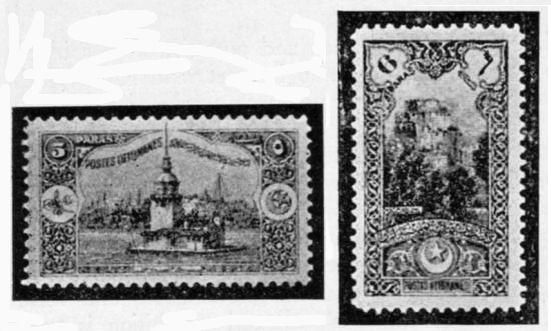


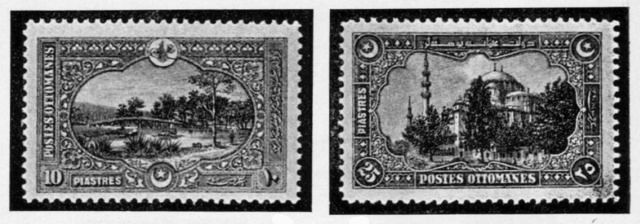
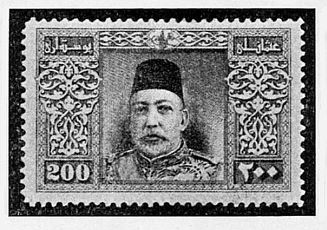
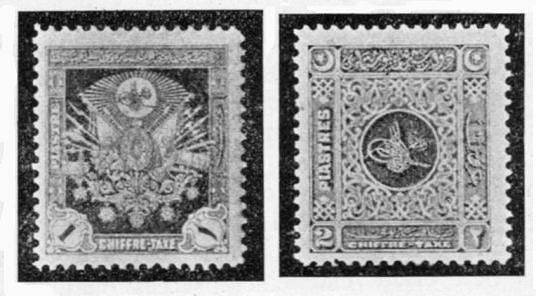
In addition there were issued four postage due stamps, one bearing the warlike "Arms" of Turkey, and the other the Thoughra, or sign-manual, of Sultan Muhammed V.
World War I and the End of the Ottoman Empire
 Turkey signed the secret Ottoman-German Alliance on August 2, 1914, and entered hostilities on the side of the Central Powers in October 1914. The war and its disruptions are reflected in Turkey's stamps issued during the war, which included stamps depicting soldiers and battle scenes, a number of provisional stamp issues in which available stocks of older issues were overprinted due to paper shortages, and stamps issued to collect a tax for war orphans. Remainders of stamps as old as 1865 were overprinted, some of which already had overprints, and sometimes multiple new overprints were added, resulting in a complex variety of configurations of interest to philatelists.
Turkey signed the secret Ottoman-German Alliance on August 2, 1914, and entered hostilities on the side of the Central Powers in October 1914. The war and its disruptions are reflected in Turkey's stamps issued during the war, which included stamps depicting soldiers and battle scenes, a number of provisional stamp issues in which available stocks of older issues were overprinted due to paper shortages, and stamps issued to collect a tax for war orphans. Remainders of stamps as old as 1865 were overprinted, some of which already had overprints, and sometimes multiple new overprints were added, resulting in a complex variety of configurations of interest to philatelists.
The Allied Forces were victorious and occupied Constantinople, after which the Ottoman government collapsed. The Treaty of Sèvres, August 10, 1920 confirmed the dismemberment of the Ottoman empire.
Foreign Post Offices in Turkey
Even before Turkey had on its part opened hostilities in the First World War, it produced an important effect upon the postal arrangements of Turkey by the "abolition of the Capitulations" which took effect on October 1, 1914. The various Powers interested in Turkey have for many years maintained agencies of their own postal administrations in Constantinople and other parts of the Turkish Empire, and these, owing to the untrustworthiness of the Turkish service, secured the bulk of the foreign correspondence both of Europeans and Turks. Latterly, Turkey has been endeavouring to compete more keenly with these rival post offices within its own dominions, and they have sold specially earmarked stamps to business firms for use on foreign correspondence at a substantial discount off face value.
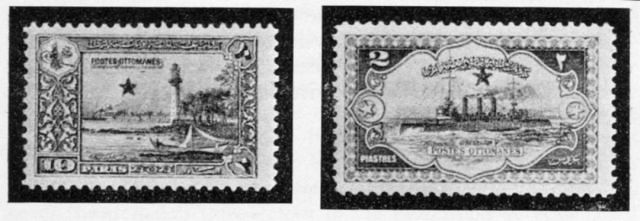
The star overprinted in blue or red on the current stamps indicates those sold in this way.
Each of the foreign post offices in Turkey, including our own British post office, used special stamps. Years ago, when the British office was first set up, ordinary English stamps were sold, but there were abuses of the currency values so that it was found desirable to overprint our English stamps for use in Turkey with either the value in Turkish currency, or with the word LEVANT, which effectually prevented any large purchases in Turkish money being exchanged at the English face value. The Turkish Government has long been trying to get these foreign post offices closed, but without success until the outbreak of the present war; they are all now closed, and their stamps consequently obsolete. The nations having had special stamps for their post offices in Turkey are:—
- Great Britain (closed October, 1914).
- France (closed October, 1914).
- Russia (closed October, 1914).
- Italy (closed October, 1914).
- Roumania (discontinued 1896).
- Austria (closed October, 1914).
- Germany (closed October, 1914).
Thessaly
A curious set of stamps, never really required for postal duty, was issued by the Turks during the Graeco-Turkish War of 1898, under the pretext of being required for the use of the Turkish Army of Occupation. The Turkish inscription on these odd-shaped stamps reads "Special for Thessaly, that part of the country conquered." Even at the time these stamps first saw the light in Thessaly, the Turks were boarding their transports to evacuate the country. Large remainder stocks have been sold since the evacuation, and extensive forging of these stamps has been detected.
Includes edited excerpts from The Project Gutenberg e-Book of The Postage Stamp in War, by Fred. J. Melville

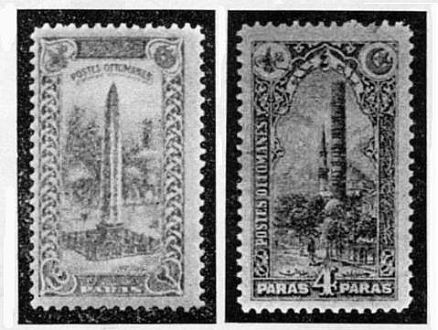
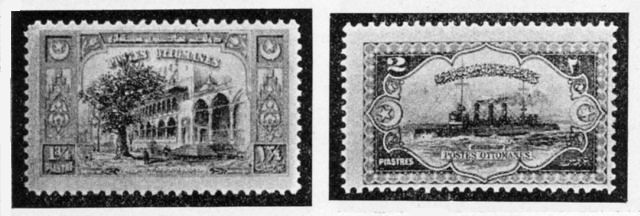

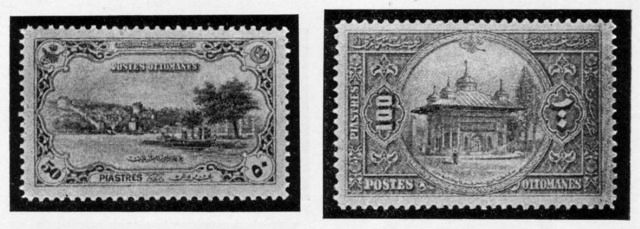

This is totally awesome. Although variety of article on this topic, this article contains some of the precious
ReplyDeletepoints which were never be read in other articles.
palitana pincode
Turkey entered the UPU in 1875. Why did its UPU title change in or around 1949 to "Turkey in Asia" and special airmail rates applied? Before then it seems that postal rates to Turkey were at the European rates.
ReplyDelete